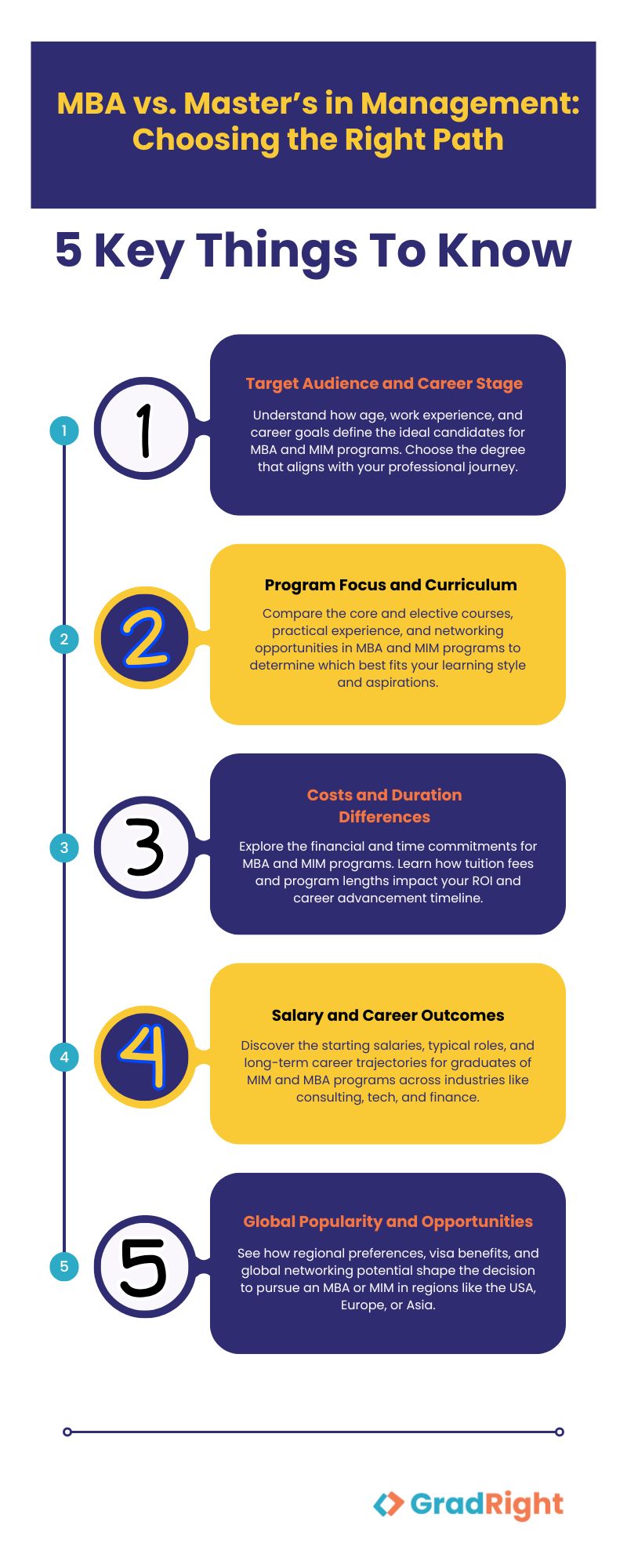MBA vs Master’s in Management: How to Choose the Best Alternative for You
If you’re considering a business degree beyond undergraduate education, you’ll have to choose between a Master’s in Management and an MBA. And don’t worry if the choice seems daunting, many students have made their choice before you, and many students will make the same choice after you.
No matter what you choose, you’ll have a secure, high-paying career ahead of you. For instance, it is well documented that MBA students on average earn $3,000 more per month after graduating according to a 2024 Indeed article.
A report published by Georgia Tech’s Scheller College of Business says that people who complete a “decent” MBA can easily touch $200,000 per year in compensation within five years of graduating. It’s the same with MIM graduates, who get an immediate 30% to 40% bump in pay after graduating, according to a September 2024 article by The Financial Times.
So then, which is better: a Master’s in Management vs. an MBA? We’ll break it down.
Through the course of this guide, we will cover the following topics:
So without any more delay, let’s get right into it.

What is the difference between a Master’s in Management and an MBA?
Whenever someone asks the difference between a Master’s in Management vs. an MBA, we always tell them the same thing. A Master’s in Management is more oriented towards younger people, looking to kick start their career in the business world. And an MBA in Business Management is more for professionals who are either:
- Looking to pivot their career into a different field, or
- Looking to advance their careers, get a promotion, etc.
But, that said, there are several more nuanced differences between a Master’s in Management vs. an MBA. Let’s look at some of these differences.
Here’s an at-a-glance table that shows the main differences between a Master’s in Management vs. an MBA:
| Aspect | MIM | MBA |
| Target Age | 22 or under | 25-30 |
| Work Experience | 0-1 year | 2-10 years |
| Program Duration | 1-2 years | 1-2 years |
| Average Tuition | $30,000 – $50,000 | $60,000 – $176,000 |
| Career Goals | Entry-level management | Senior leadership roles |
| Geographical Popularity | Europe | United States |
Now, let’s take a deeper look at the differences.
-
Target Student Profile
An MIM is targeted at fresh graduates or early-career professionals. If you’re at the start of your career and need to build a strong foundation in business, MiM is a great choice. An MBA though is designed for individuals with substantial work experience (usually 3–10 years). These are people who are looking to enhance leadership skills, transition industries, or accelerate career growth.
-
Program Focus
An MIM provides broad, theoretical knowledge of business concepts, such as marketing, finance, and organisational behaviour. These programs aim to let students enter the business workforce.
A Master of Management focuses on building fundamental business knowledge. Students learn the basics of how companies operate, including introductory finance, marketing, and management principles. You could argue that it is a bridge between a BBA and an MBA.
The teaching style is more traditional, with structured classes and theoretical frameworks forming the foundation of learning. Think of it as learning the language of business from the ground up.
On the other hand, an MBA program assumes you already speak the basic language of business. It aims to give you advanced leadership skills and teach you to think strategically.
A lot of time will be spent on case studies and real-life problems being faced by companies. This is why work experience is so crucial for MBA programs – your peers will learn from your past experience, and you from theirs.
MBA’s offer rather specialised (niche) and practical learning with lots of weight put on real-world applications. MBA programs often include case studies, internships, and leadership training.
-
Cost and Duration
MIMs are shorter and less expensive, typically lasting 10 months to 2 years. This makes it a more affordable option for students with limited savings or funding.
MBAs need a (much) more significant financial investment. However, with that extra cost you get access to an even more advanced curriculum, better global networking opportunities, and possibly a better reputation.
For example, a graduate from an M7 MBA will easily get a job in Europe, but someone with a top 10 Euro MIM may struggle to get a placement in the USA.
PS, M7 is just the top 7 MBA schools in the USA — Harvard, Columbia, Wharton, Chicago Booth, MIT, Stanford, and Northwestern Kellogg.
-
Post-Graduation Opportunities
MiM Graduates often start in entry-level roles such as analysts, associates, or coordinators. The degree provides a stepping stone to climb the corporate ladder.
MBA Graduates almost always qualify for mid-to-senior-level roles, Examples of common post-MBA roles are consultants, managers, and directors. MBA alumni often command higher salaries and more significant responsibilities.
-
Program Popularity
MiMs are most popular in Europe, where they originated. However, they are increasingly gaining traction in other regions, especially Asia.
An MBA though is universally recognized and highly regarded, especially in the United States, Canada, and of course, at home in India.
Now that you’ve understood the differences between a Master’s in Management vs. an MBA, let’s talk about the student profiles for each.
Differences in a Master’s in Management vs. an MBA student profile
We gave you a brief overview of the student profiles for an MBA vs. an MS in Management in the previous section.
Let’s go a little deeper.
Here’s a small table to give you a quick overview of the student profile for each degree:
| Aspect | MIM | MBA |
| Age | Typically 21–25 | Typically 27–35 |
| Work Experience | 0–2 years | 3–10 years |
| Education Background | Recent graduates, often non-business degrees | Professionals with diverse academic fields |
| Career Stage | Early career or fresh graduates | Mid-to-senior-level professionals |
| Goals | Build foundational business knowledge | Leadership roles, career pivot, or acceleration |
- Age and Background
Based on the class profiles from top business schools like Wharton, Harvard, Stanford INSEAD, HEC Paris and IESE, both programs attract distinctly different student populations. The Master of Management typically draws students averaging 23 years old, with participants ranging from 21-25. In contrast, MBA cohorts average 29 years old, with most students between 26-32.
- Academic Diversity
Another major difference is seen in terms of where the students come from academically. Master’s in Business Management / Master’s in Science in Management programs have a very wide student base. You’ll find everyone from people who have Bachelor’s degrees in performing arts to people who’ve studied nuclear engineering. MBA programs are also very diverse, but nowhere near MIM programs. There are two groups of students in MBA programs: those already in business, or those looking to pivot to business.
- Professional Maturity
An MIM student has under two years of work experience, and a bulk of that will probably be an internship. After all, they are just beginning their professional journey. On the flip side, MBA candidates can have anywhere from 3 to 8 years of experience on average. Many MBA candidates are already in middle leadership positions and have managed teams, led projects, or run their own companies.
- Cultural Mix
Both programs boast impressive international diversity, but in different ways. Leading MIM programs, especially in Europe, often have student bodies representing 30+ nationalities. Another key aspect is that they operate in smaller cohorts of 100-200 students. MBA programs, particularly in the US, have larger classes (800+ at top schools) with strong representation from Asia, Europe, and the Americas.
- Career Focus
MS MANAGEMENT students typically seek their first formal business role and are open to exploring various functions and industries. They’re building their professional identity. MBA students, however, usually come with clearer career goals. This could be switching industries, advancing in their current field, or preparing for senior leadership roles.
Now, you’ve understood the student profiles and how they differ for a Master’s in Management vs. an MBA. In the next section, we’ll do a program comparison for each.
Master’s in Management vs. MBA program comparison
To compare both programs, let’s look at the curricula of both programs.
MIM Curriculum
The MiM curriculum is tailored for early-career professionals, often focusing on foundational business concepts.
Here are some key components typically included in a Master’s in Management program:
- Core Courses: The MiM usually begins with core courses that cover essential topics such as:
- Finance
- Business Analytics
- Accounting
- Marketing
- Strategy
- Micro/Macroeconomics
- Human Resources
- Elective Courses: After completing core courses, students can choose electives that allow them to specialise in areas of interest, such as digital marketing, international business, or entrepreneurship.
- Practical Experience: Many MiM programs incorporate practical training through internships or project work. For example, programs like INSEAD’s MiM include a professional exposure module where students gain real-world experience in a company setting.
- International Exposure: Students often have opportunities for international study trips, which help them understand global business practices and cultural differences.
MBA Curriculum
The MBA curriculum is designed for professionals with some work experience who are looking to advance their careers or make significant career changes.
Here’s what you can typically expect from an MBA program:
- Core Courses: Similar to the MiM, MBA programs begin with core courses covering fundamental business topics:
- Finance
- Business Analytics
- Accounting
- Marketing
- Strategy
- Micro/Macroeconomics
- Human Resources
- Advanced Topics: Beyond the basics, MBA programs delve into more advanced subjects such as:
- Strategic Management
- Organisational Behaviour
- Leadership Development
- Operations Management
- Internships: A critical component of many MBA programs is the summer internship between the first and second years. This allows students to gain targeted experience in their desired industry or role.
- Case Studies and Group Projects: MBA programs often utilise case studies to encourage critical thinking and problem-solving skills. Students work on group projects that simulate real-world business challenges.
- Networking Opportunities: MBA programs typically offer extensive networking opportunities through alumni connections, industry events, and guest lectures from business leaders.
The MiM is ideal for recent graduates seeking foundational knowledge and practical experience, while the MBA is suited for experienced professionals looking to advance into leadership positions.
And now that we’ve finished comparing an MIM to an MBA, let’s talk a little bit about salary and career opportunities.
Master’s in Management vs. MBA salary and career opportunities
Here is a table comparing the (starting) annual salaries of graduates of a Master’s in Management vs. an MBA in Business Administration:
| Industry | Master’s in Management (MiM) | MBA |
| Consulting | $65,000 – $85,000 | $165,000 – $200,000 |
| Financial Services | $60,000 – $80,000 | $150,000 – $180,000 |
| Technology | $70,000 – $90,000 | $140,000 – $175,000 |
| Consumer Goods | $55,000 – $75,000 | $125,000 – $150,000 |
| Healthcare | $60,000 – $80,000 | $130,000 – $160,000 |
| Manufacturing | $55,000 – $70,000 | $120,000 – $145,000 |
All figures were for November 2024, sourced from Indeed and Glassdoor, and are subject to change.
Next, let’s talk about career progression after graduation.
Short Term Career Growth
Master’s In Management graduates typically start in:
- Associate Consultant roles at top consulting firms
- Financial Analyst positions in investment banks
- Business Development roles in tech companies
- Marketing Coordinator positions in consumer goods
- Project Coordinator roles in various industries
MBA graduates typically start in:
- Senior Management Consultant positions
- Investment Banking Associate roles
- Product Management leadership
- Senior Strategy roles
- Corporate Development positions
- General Management rotational programs
Long-term Career Growth
The five-year career trajectory for Master of Management graduates often includes:
- Starting in entry-level positions
- Moving to mid-level management in 3-4 years
- Potential for senior roles after 5-7 years
- Option to pursue an MBA for career acceleration
- Average salary growth of 40-50% over five years
The five-year career trajectory for MBA graduates often includes:
- Immediate senior-level positions
- Fast-track to executive roles
- Significant responsibility from day one
- Average salary growth of 80-100% over five years
- Access to C-suite positions within 8-10 years
That ends the section on salaries and careers after an MIM vs. an MBA. In our last section, we’ll cover which one is right for you.
Which is better: A Master’s in management or an MBA?
When making this choice, focus on your career stage and goals rather than program rankings or prestige. If you’re a recent graduate, under 25 years old, and with under 2 years of work experience, the MIM is your better bet. Especially if you are an Indian national, consider a French MIM.
The French Government has strong ties with India, and you are eligible for a special postgraduate work visa that is a direct pathway to residency if you play your cards right.
You can learn more about this on the Campus France Website, called the Talent Passport Visa.
European MIM programs are a lot more affordable than MBA programs, and in most countries come with a four-year work permit.
This is barring the UK (2 years) and USA (1 year to 3 years max). So at minimum, as a young professional, you’d have four years to earn back your investment outside the UK and the USA.
If you’re a mid-career professional who has some savings and a nest egg, shoot for an MBA. It’s the more prestigious of the two degrees, will open a lot more doors, and has a better network and alumni.
With that said, we come to the end of this article. We hope you found it useful, and we’ll see you in the next one.
When deciding between an MBA or a Master’s in Management (MIM), choosing the right program is only half the battle. The next critical step is finding the perfect university and financing your education smartly. This is where GradRight’s university-search platform and loan-search platform step in to simplify the process.
With GradRight’s university-search platform, you don’t have to rely solely on rankings. Instead, it uses:
- 100% AI-powered shortlisting to match you with programs that fit your goals.
- Insights from 8 million data points covering 40,000+ programs across 4,000+ universities worldwide.
- Information on placement rates, alumni network strength, and ROI metrics to make well-informed choices.
- Tailored recommendations to ensure the program aligns with your career stage and aspirations.
Once you’ve selected the right program, GradRight’s loan-search platform ensures your financial planning is hassle-free:
- 15 trusted banks and NBFCs compete to offer you the best loan terms.
- No paperwork or bank visits—it’s entirely app-based.
- 100% free for applicants, with safe and easy loan documentation.
- Access to collateral-free loans and flexible options designed for students.
- Quick disbursement so you can focus on your education, not the process.
By combining GradRight’s university-search platform for university selection and GradRight’s loan-search platform for education loans, you set yourself up for success without unnecessary stress.
Now, let’s dive into some FAQs to answer your remaining questions about MBAs and MIMs.
Frequently Asked Questions
1. Is a Master’s in Management better than an MBA?
A Master’s In Management (MIM) is better if you’re just starting your career and need foundational business knowledge. However, an MBA is better for experienced professionals looking to advance or transition into leadership roles. It depends on your career stage and goals.
2. What is the best alternative to an MBA?
The best alternative to an MBA can vary based on your career goals. Options include a Master’s in Management, a Master of Science in Finance, or specialised certifications like Project Management Professional (PMP) or Chartered Financial Analyst (CFA).
3. How to choose between an MBA and an MS?
Choose based on your experience and goals. Pick an MBA if you have work experience and want a general management role. Choose an MS if you’re a recent graduate or want to specialise in a specific field (like finance or data science). Consider your budget too – MS programs typically cost less than MBAs.
4. Who earns more, an MBA or a Master’s?
Generally, MBA graduates tend to earn more than those with a Master’s in Management. MBA graduates often enter higher-level positions with greater responsibilities, which typically come with higher salaries.
5. Which is better, an MBA in India or an MS in the USA?
An MBA in India may offer strong local job opportunities and networks, while an MS in the USA might provide access to global companies and diverse experiences. Consider factors like cost, location, and industry when making your decision.















